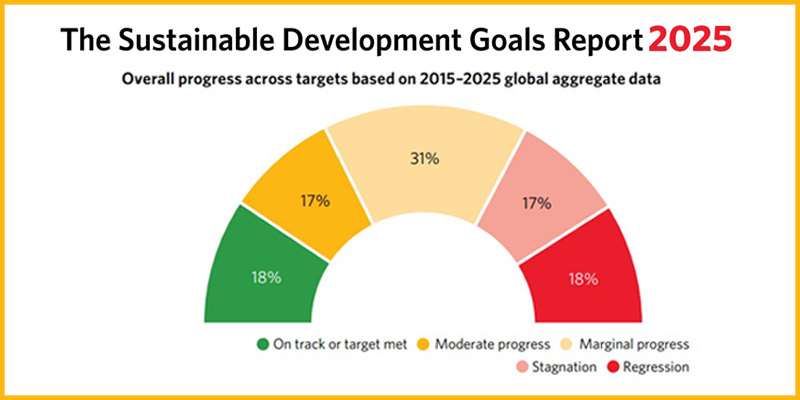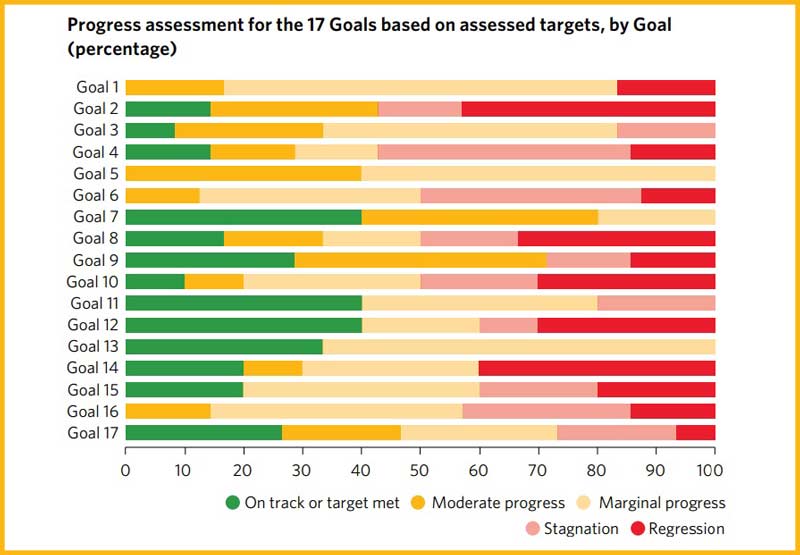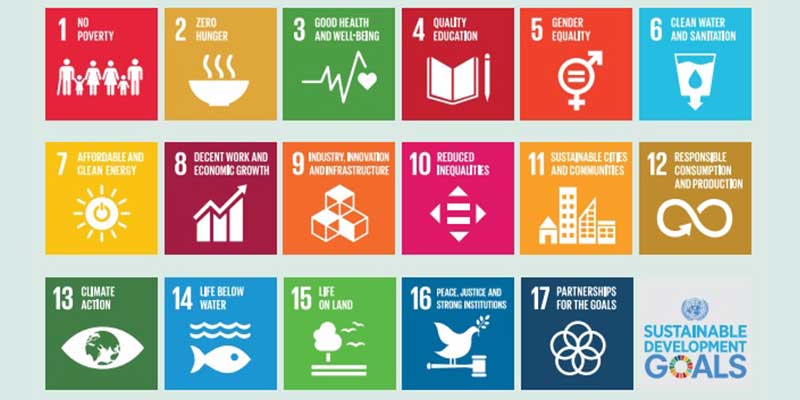- World
- Jul 17
10 years of adoption of Sustainable Development Goals (SDGs)
• A decade after the adoption of the 2030 Agenda for Sustainable Development, the United Nations released the 10th edition of its annual progress report, Sustainable Development Goals Report 2025.
• The report provides a stark assessment and a strong call for action.
• While millions of lives have improved, through gains in health, education, energy, and digital connectivity, the pace of change remains insufficient to meet the Goals by 2030.
• The latest available data show that only 35 per cent of targets are on track or making moderate progress, while nearly half are moving too slowly and 18 per cent have regressed.
Sustainable Development Goals (SDGs)
• The Sustainable Development Goals (SDGs) were adopted by all UN member states in 2015 as a universal call of action to end poverty, protect the planet and ensure that all people enjoy peace and prosperity by 2030.
• Also known as the Global Goals, the SDGs are a call to action to create a world where no one is left behind.
• It consists of 17 goals and 169 targets.
• The SDGs are the blueprint to achieve a better and more sustainable future for all. They address the global challenges we face.
• The SDGs are a call for action by all countries – poor, rich and middle-income – to promote prosperity while protecting the planet.
• They recognise that ending poverty must go hand-in-hand with strategies that build economic growth and address a range of social needs including education, health, social protection, and job opportunities, while tackling climate change and environmental protection.
Progress amid adversity
• New HIV infections have declined by nearly 40 per cent since 2010.
• Malaria prevention has averted 2.2 billion cases and saved 12.7 million lives since 2000.
• Social protection now reaches over half the world’s population, up significantly from a decade ago.
• Since 2015, 110 million more children and youth have entered school.
• Child marriage is in decline, with more girls staying in school and women gaining ground in parliaments around the world.
• In 2023, 92 per cent of the world’s population had access to electricity.
• Internet use has surged from 40 per cent in 2015 to 68 per cent in 2024, unlocking access to education, jobs, and civic participation.
• Conservation efforts have doubled protection of key ecosystems, contributing to global biodiversity resilience.
Hard truths and systemic risks
• More than 800 million people still live in extreme poverty.
• Billions still lack access to safe drinking water, sanitation, and hygiene services.
• Climate change pushed 2024 to be the hottest year on record, with temperatures 1.55°C above pre-industrial levels.
• Conflicts caused nearly 50,000 deaths in 2024. By the end of that year, over 120 million people were forcibly displaced.
• Low and middle-income countries faced record-high debt servicing costs of $1.4 trillion in 2023.
The report calls for action across six priority areas where intensified effort can generate transformative impact — food systems, energy access, digital transformation, education, jobs and social protection, and climate and biodiversity action.
The 17 SDGs and the current status
1) No poverty
• Extreme poverty persists, affecting one in 10 people worldwide.
• Recent crises have stalled progress, with the burden falling heavily on sub-Saharan Africa and conflict-affected regions.
• Without a significant acceleration in efforts, 8.9 per cent of the global population will still be living in extreme poverty by 2030, under the revised international poverty line.
• Similarly, at the current trajectory, only one in five countries are projected to have halved its national poverty by 2030.
• For the first time on record, over half of the world’s population now receives at least one form of social protection benefit. Despite this milestone, 3.8 billion people remain uncovered.
2) Zero hunger
• Global hunger has risen sharply since 2019 and remains persistently high. Nearly one in 11 people worldwide faced hunger in 2023, while more than two billion experienced moderate to severe food insecurity.
• Hundreds of millions of children and women are affected by malnutrition, and dietary diversity remains inadequate for both women and young children.
• While the share of countries with high food prices declined from 60 per cent in 2022 to 50 per cent in 2023, this is still more than three times pre-pandemic norms.
3) Good health and well-being
• Global health progress is slowing after decades of gains. Between 2000 and 2019, maternal and child mortality declined significantly; the HIV incidence rate fell; and healthy life expectancy increased by over five years.
• However, COVID-19 reversed some of these gains, cutting life expectancy by 1.8 years and slowing progress towards nearly all health-related SDG targets.
• Global maternal mortality ratio dropped from 228 deaths per 100,000 live births in 2015 to 197 in 2023. Under-5 mortality fell to 37 deaths per 1,000 live births in 2023, a 16 per cent reduction from 44 in 2015.
• Infectious and non-communicable diseases remain major threats. AIDS-related deaths have halved since 2010, and 54 countries have eliminated at least one neglected tropical disease.
• Meanwhile, malaria cases are rising; tuberculosis returned to being probably the world’s leading cause of death from a single infectious agent in 2023; and non-communicable diseases killed 18 million people under age 70 in 2021.
• Risk factors such as tobacco use, air pollution and poor diet remain insufficiently addressed.
• Deep inequalities and underresourced systems persist. Despite a growing health workforce and expanded services, major inequalities persist.
• Low-income and fragile settings face the highest risks due to underfunded systems, service gaps and workforce shortages.
4) Quality education
• Education is vital for sustainable development, yet progress remains off track. While enrolment and completion rates have improved since 2015, with girls outperforming boys in most regions, progress is slowing.
• Meanwhile, 272 million children and youth remained out of school in 2023.
• Learning outcomes are declining in many countries. Although literacy has improved modestly, hundreds of millions of people remain illiterate, with women disproportionately affected. Deep inequalities persist due to gender, wealth and geography.
5) Gender equality
• Three decades after the landmark Beijing Declaration and Platform for Action, gender equality remains elusive. Despite progress, discriminatory laws and gender-based norms continue to hinder gender equality.
• Women remain underrepresented in decision-making and leadership roles and often lack autonomy over sexual and reproductive health, land rights and technology access.
• Women’s disproportionate share of unpaid domestic and care work continues to limit their access to education, career opportunities and political engagement, while harmful practices, such as child marriage and female genital mutilation (FGM), persist globally.
• Well-designed public finance systems are essential for financing gender equality commitments. However, only 26 per cent of 121 countries and areas have comprehensive systems to track resource allocations for gender equality — unchanged since 2021 — highlighting persistent capacity gaps in accurately costing, allocating and spending resources to
implement national gender equality laws and policies.
• Between 2019 and 2024, as many as 99 positive legal reforms were implemented to remove discriminatory laws and establish gender equality frameworks.
• As of January 1, 2025, women held 27.2 per cent of the seats in national parliaments, up 4.9 percentage points from 2015.
6) Clean water and sanitation
• While steady progress expanded access to drinking water, sanitation and hygiene services between 2015 and 2024, billions remain underserved. In 2024, as many as 2.2 billion people lacked safely managed drinking water, 3.4 billion went without safely managed sanitation and 1.7 billion lacked basic hygiene services at home.
• In schools, 646 million children remain without basic hygiene services, requiring a fourfold increase in progress to meet 2030 targets.
• Water systems are under strain from pollution, water stress and weak governance. Only 56 per cent of domestic wastewater is safely treated, water stress remains critical in several regions, freshwater ecosystems are declining, and transboundary cooperation is limited.
• At the current rate, the world will not achieve sustainable water management until at least 2049.
7) Affordable and clean energy
• The world has made considerable progress towards Goal 7. Global electricity access reached 92 per cent in 2023 – up from 84 per cent in 2010.
• Meanwhile, access to clean cooking fuels and technologies rose from 64 to 74 per cent between 2015 and 2023.
• Renewable energy is the fastest-growing energy source today, and it is projected to surpass coal as the primary electricity source in 2025.
• Without accelerated investments and action, 645 million people will still lack electricity access, and 1.8 billion will lack access to clean cooking in 2030.
8) Decent work and economic growth
• Global economic growth is falling short. GDP per capita growth is projected to slow to just 1.5 per cent in 2025 due to heightened trade tensions and policy uncertainty. Real GDP growth in least developed countries (LDCs) remains well below the 7 per cent target.
• Weak productivity growth and declining labour rights compliance further undermine decent-work progress.
• While the unemployment rate fell to a record low of 5 per cent in 2024, nearly 58 per cent of workers remained informally employed, with persistently high rates in LDCs and sub-Saharan Africa. Youth and women continued to face particularly elevated unemployment and NEET (not in education, employment or training) rates.
9) Industry, innovation and infrastructure
• Since 2015, notable progress has been made in expanding infrastructure, fostering industrial growth and boosting innovation. Global manufacturing value added (MVA) per capita grew 17.3 per cent from 2015 to 2024.
• Maritime freight reached 11.6 billion metric tonnes in 2023, driven by the growing participation of developing countries.
• Meanwhile, 5G mobile broadband now covers 51 per cent of the global population.
• However, stark regional disparities persist, and many developing countries continue to face systemic barriers to inclusive and sustainable industrialisation.
• Emissions hit a new high despite clean energy growth. Carbon dioxide (CO2) emissions from fuel combustion and industrial processes rose to a record 37.6 billion metric tons in 2024, up 8.3 per cent since 2015.
• Clean energy technologies helped curb further growth, but global emissions continue to rise amid increasing energy demand.
10) Reduced inequalities
• Since 2015, most countries have seen income and consumption growth for the bottom 40 per cent of their population outpace the national average, though disparities persist among regions and countries at different income levels. The labour income share of GDP fails to show progress, contributing to rising inequality.
• Reports of discrimination are rising globally, with higher prevalence among urban residents, women, persons with disabilities, the poorest and those with lower education levels.
• The global refugee population has surged to 37.8 million — primarily from Afghanistan, the Bolivarian Republic of Venezuela, the Syrian Arab Republic and Ukraine — intensifying humanitarian pressures.
• Total resource flows to developing countries have increased, with official development assistance (ODA) forming a larger share. Given current trends in international cooperation, however, the future of ODA appears uncertain and potentially constrained.
11) Sustainable cities and communities
• With rapid urbanisation and now over half the world’s population living in cities, housing affordability has reached crisis levels. Up to three billion people worldwide struggle to afford a place to live, and 1.12 billion live in slums or informal settlements without basic services.
• Climate threats intensify urban vulnerabilities. Cities are central to climate change efforts as urban populations grow, with rising temperatures and flood risks threatening billions. Open green spaces are disappearing, undermining climate resilience.
• Only 19 per cent of cities across 50 countries demonstrate strong civil society participation in urban planning, threatening equity and effective service delivery, particularly for marginalised groups.
12) Responsible consumption and production
• Food waste, food loss and electronic waste are reaching unprecedented levels, while rising consumption continues to drive increases in domestic material consumption and material footprint.
• These trends are placing growing pressure on the environment, accelerating climate change and exacerbating global resource inequalities.
• However, momentum towards sustainable consumption and production is building at the institutional level.
• Governments are adopting supportive policies; companies are expanding sustainability reporting, and participation in multilateral environmental agreements is increasing, reflecting strong institutional commitment.
13) Climate action
• Climate change is accelerating, with 2024 marking the hottest year on record, at approximately 1.55°C above pre-industrial levels.
• Extreme weather is intensifying, driving the highest climate-related displacement in 16 years and worsening food insecurity, economic losses and instability.
• Although one year above 1.5°C does not mean the Paris Agreement has been breached, it serves as a clarion call for increasing ambition and accelerating action in this critical decade, as current global efforts fall far short of what is needed.
14) Life below water
• Oceans and seas are vital to life on Earth, regulating climate, sustaining biodiversity, supporting livelihoods and food security, enabling global trade and providing countless ecosystem services.
• Yet they face mounting threats from overfishing, pollution, biodiversity loss and climate change.
• Despite growing conservation efforts, only 8.4 per cent of the ocean is classified as marine protected areas, far short of the target of 30 per cent by 2030, and just 46 per cent of marine key biodiversity areas are under protection.
• Ocean warming and acidification continue, overfishing and illegal practices persist, and support for small-scale fisheries remains insufficient.
15) Life on land
• Persistent challenges continue to hinder progress in protecting life on land, managing natural resources sustainably and combating the biodiversity crisis.
• Global forest cover is shrinking; protection of key biodiversity areas (KBAs) has stalled recently, and species extinction is accelerating.
• Yet, there are signs of progress. Global forest loss is slowing, and regional advances show promise. Voluntary land restoration commitments would cover two thirds of what is needed. Conservation of KBAs has steadily increased over two decades through successful global site-level efforts.
• Biodiversity-related official development finance has also shown a positive trend.
16) Peace, justice and strong institutions
• Violence and conflict continue to drive human suffering and displacement. In 2024, nearly 50,000 lives were lost to conflict — one every 12 minutes — disproportionately affecting women and children.
• By the end of 2024, 123.2 million people were forcibly displaced. While global homicide rates fell by 12 per cent between 2015 and 2023, progress remains far below the 50 per cent reduction target.
• Access to justice remains elusive: one in three prisoners worldwide are held without a proper sentence, and risks to human rights defenders and journalists persist.
• The number of journalist killings rose by 11 per cent in 2024, with conflict zones especially dangerous.
• There are signs of progress. Budget reliability has improved, access-to-information laws expanded, and more countries now have compliant human rights institutions. Still, significant gaps remain in building effective, accountable and inclusive institutions.
17) Partnerships for the goals
• Low and middle-income countries faced record-high $1.4 trillion debt-servicing costs in 2023, compounded by a $4 trillion annual investment gap that severely constrained SDG achievement.
• Despite increased financial flows from official and private sources, ODA declined by 7.1 per cent after five years of growth, with further cuts expected through 2025.
• The share of developing countries in global merchandise exports has remained stagnant since 2015, with least developed countries accounting for just 1.1 per cent – far below the SDG target to double their share by 2020.
• Access to information and communications technology continues to expand, but the digital divide remains wide, especially in lower-income regions.
• While data systems and national statistical capacities have improved, many countries still lack sustainable financing to support the data infrastructure and production needed to meet growing demands.
Manorama Yearbook app is now available on Google Play Store and iOS App Store



